Pieter Brueghel the Younger stands as a pivotal figure in the rich tapestry of Flemish art history. Born into perhaps the most famous artistic dynasty of the Low Countries, he navigated a career defined by both filial devotion and individual creativity. Active during the late 16th and early 17th centuries, a period of significant cultural and political change, Brueghel the Younger carved out a unique niche for himself, primarily known for his prolific production of copies after his celebrated father's works, yet also recognized for his own distinct contributions to Flemish painting. His life and work offer a fascinating window into the practices of art production, the dynamics of family legacy, and the enduring appeal of genre scenes in Northern European art.
Multiple historical sources converge to establish the lifespan of Pieter Brueghel the Younger. Born in Brussels around 1564, he lived through a dynamic era, ultimately passing away in Antwerp in 1638. These dates place him firmly within the later stages of the Flemish Renaissance and the burgeoning Baroque period, witnessing the artistic shifts that characterized Antwerp's golden age, even amidst the turbulence of the Eighty Years' War. His longevity allowed him to oversee a large and productive workshop for decades, significantly shaping the art market of his time.
Early Life and Artistic Formation
Pieter Brueghel the Younger's entry into the world of art was almost preordained, yet marked by early tragedy. He was the eldest son of the legendary Pieter Bruegel the Elder, a towering figure whose innovative depictions of peasant life and landscapes had revolutionized Northern Renaissance art. However, the elder Bruegel died in 1569, when Pieter the Younger was merely five years old. His mother, Mayken Coecke van Aelst (daughter of the prominent artist Pieter Coecke van Aelst), passed away not long after, in 1578.
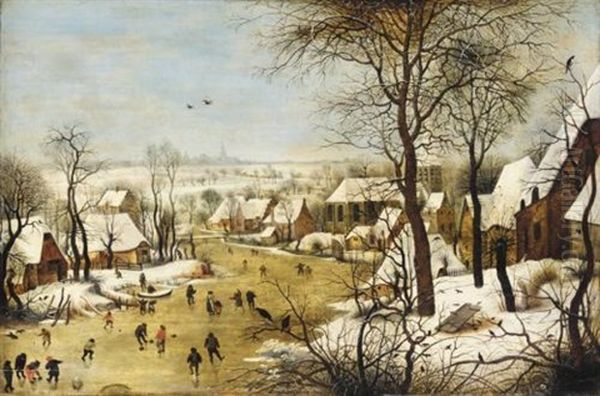
Orphaned at a young age, Pieter and his younger brother, Jan Brueghel the Elder (later known as 'Velvet' Brueghel), along with their sister Marie, were raised by their maternal grandmother, Mayken Verhulst. This was a stroke of fortune for the young aspiring artists, as Verhulst was herself an accomplished painter, particularly noted for miniatures and watercolors. It is widely believed that she provided the brothers with their initial artistic instruction, grounding them in the techniques and traditions of the craft. This early exposure within a family deeply embedded in the artistic profession was crucial.
Formal training likely continued under the landscape painter Gillis van Coninxloo. Van Coninxloo was not only a respected artist but also connected to the family; his wife was related to the Brueghels. This apprenticeship would have further honed Pieter's skills, particularly in landscape depiction, a genre central to his father's oeuvre. By 1585, Pieter Brueghel the Younger had achieved professional recognition, being accepted as an independent master into the prestigious Guild of Saint Luke in Antwerp. This membership was essential for any artist wishing to practice professionally, take on apprentices, or sell works within the city, which was then a major European art center.
The Antwerp Workshop: A Prolific Enterprise
Upon establishing himself in Antwerp, Pieter Brueghel the Younger set up a workshop that would become remarkably productive and commercially successful. This was not a small, solitary studio but a large-scale operation, likely employing numerous assistants and apprentices. The demand for works in the style of his famous father was immense, and Pieter the Younger capitalized on this market expertly. His workshop became a primary source for paintings echoing Pieter Bruegel the Elder's popular themes: bustling village festivals, harsh but beautiful winter landscapes, and vivid religious narratives enacted by common folk.
The workshop's output was varied. It produced relatively inexpensive, quickly executed copies for a broader market, ensuring the wide dissemination of Brueghelian imagery. However, it also created high-quality, meticulously finished paintings, both copies and original compositions, destined for wealthier patrons and collectors across Europe. This business model proved highly effective, making Pieter the Younger a prosperous artist. His success is evidenced by the sheer number of surviving works attributed to him and his studio, estimated to be in the hundreds, possibly thousands.
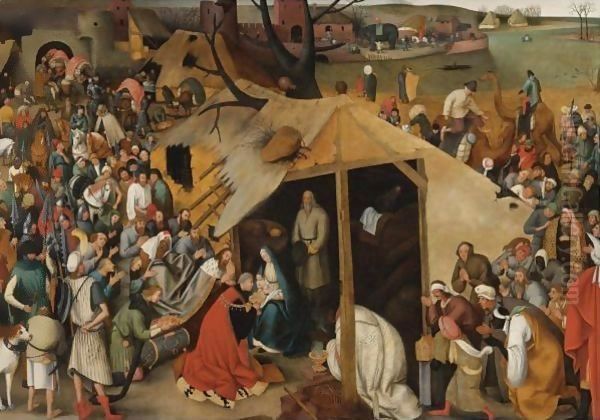
Among the artists known to have worked in his circle or as assistants were figures who would later gain renown in their own right. While direct employment records can be scarce, the collaborative nature of Antwerp workshops suggests interaction with many artists. His own nephew, Jan Brueghel the Younger (son of Jan Brueghel the Elder), followed the family tradition and likely spent time in the workshop. Frans Snyders, later a leading animal and still-life painter who frequently collaborated with Peter Paul Rubens, is also mentioned as having been associated with the workshop, highlighting the caliber of talent within Pieter the Younger's orbit.
The Shadow of the Elder: Copying the Master
The most defining aspect of Pieter Brueghel the Younger's career is undoubtedly his dedication to replicating the works of his father. Since Pieter the Elder died relatively young and produced a limited number of paintings (around 45 are known today), his compositions were highly sought after. Pieter the Younger had access to his father's original drawings, cartoons, and possibly unfinished panels, which served as models for the workshop's production. This practice was not seen as mere imitation in the 17th century but as a way of honoring a master, preserving influential compositions, and meeting intense market demand.
His copies were often remarkably faithful to the originals in composition, though differences in brushwork, color palette, and minor details often distinguish the son's work from the father's. Pieter the Younger tended to use brighter, sometimes harsher colors compared to his father's more subtle and harmonious tones. His figures can occasionally appear more caricatured or less individualized than those of his father. Nonetheless, the quality of many copies is exceptionally high, leading to centuries of attribution confusion.
Certain compositions by Pieter Bruegel the Elder proved especially popular and were reproduced numerous times by the workshop. Winter Landscape with Skaters and Bird Trap, based on his father's 1565 original, is perhaps the most frequently copied work, with dozens of versions attributed to Pieter the Younger and his studio surviving. Other much-replicated paintings include The Census at Bethlehem, The Adoration of the Magi, The Sermon of St. John the Baptist, various depictions of peasant weddings and dances (The Wedding Dance, The Peasant Dance), and allegorical scenes like Netherlandish Proverbs. Through this relentless replication, Pieter the Younger played a crucial role in cementing his father's fame and ensuring the widespread influence of his unique vision.
Beyond Replication: Original Contributions and Style
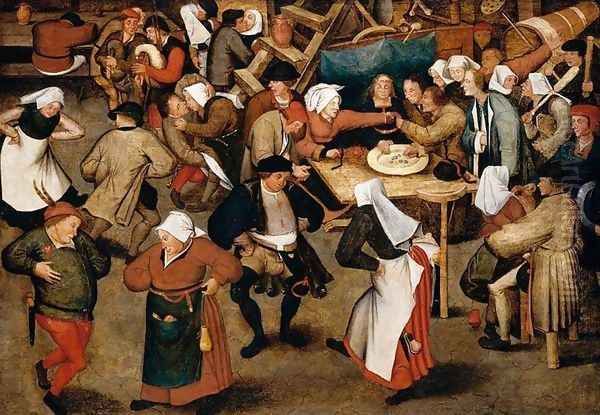
While renowned as a copyist, Pieter Brueghel the Younger was also an artist who created original compositions and adapted his father's themes with his own distinct sensibility. He developed variations on existing Bruegelian subjects, adding new details or altering compositions to suit contemporary tastes or specific commissions. For instance, his numerous versions of the Village Fair or Kermesse often elaborate on themes present in his father's work but become independent compositions showcasing his skill in organizing complex, multi-figured scenes teeming with life and anecdotal detail.
His original works often continue the focus on peasant life, religious subjects, and landscapes. Paintings like The Village Lawyer (also known as The Payment of the Tithes), depicting peasants dealing with a possibly corrupt official, showcase his satirical eye and ability to capture social commentary, a trait inherited from his father. The Whitsun Bride and various depictions of village brawls or festivities demonstrate his flair for dynamic, sometimes chaotic, scenes rendered with energetic brushwork and vibrant color. These works, while clearly indebted to his father's legacy, possess their own character.
A curious aspect of his reputation is the nickname "Helse Brueghel" or "Hell Brueghel." This moniker arose primarily from his depictions of fires and grotesque figures, particularly in subjects like The Temptation of St. Anthony or scenes involving devils and fantastical creatures, themes also explored by Hieronymus Bosch, whose influence on Pieter Bruegel the Elder was significant. While Pieter the Younger did paint such subjects, they form a relatively small part of his overall output compared to the peasant scenes and landscapes. The nickname likely stuck due to the striking, memorable nature of these works, perhaps amplified by confusion with his brother Jan, who sometimes painted underworld scenes in collaboration with others.
Family Ties and Artistic Network
Pieter Brueghel the Younger operated within a dense network of family and professional relationships that characterized the Antwerp art world. His closest artistic connection was with his younger brother, Jan Brueghel the Elder. While Pieter focused on continuing their father's legacy through copies and related genre scenes, Jan developed a distinct style, becoming famous for his refined flower still lifes, allegorical paintings, and mythological landscapes, often painted on copper with exquisite detail. Jan 'Velvet' Brueghel achieved international fame, worked for royal patrons, and famously collaborated with Peter Paul Rubens on numerous masterpieces, such as the Allegory of Sight or The Garden of Eden.
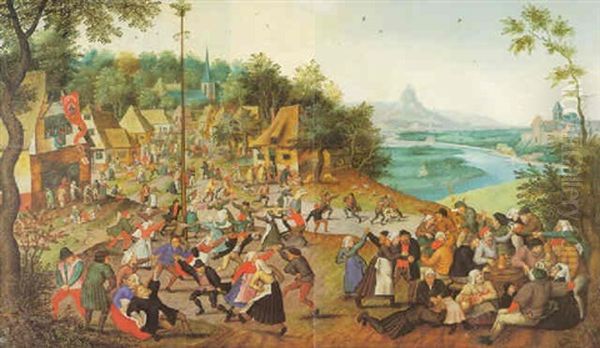
Although their artistic paths diverged, the brothers likely maintained contact and possibly shared workshop resources or models initially. Their grandmother, Mayken Verhulst, and their teacher, Gillis van Coninxloo, provided foundational links. The broader artistic milieu of Antwerp included giants like Rubens, Anthony van Dyck, Jacob Jordaens, and specialists like the still-life painter Osias Beert or the landscape artist Joos de Momper (who sometimes collaborated with Jan Brueghel the Elder). While direct collaborations between Pieter the Younger and figures like Rubens are not well-documented (unlike his brother Jan), he was certainly aware of and likely influenced by the dominant Baroque trends, even while remaining largely faithful to his father's idiom. His workshop also trained the next generation, including his own son, Pieter Brueghel III, ensuring the continuation of the family name in the art world, albeit with diminishing originality.
The Brueghel dynasty's influence extended further, impacting artists like David Teniers the Younger, who married into the family (Jan Brueghel the Elder's daughter Anna) and became a leading painter of peasant scenes in the mid-17th century, clearly building upon the foundations laid by both Pieter the Elder and Pieter the Younger. Other contemporaries like Adriaen Brouwer and David Vinckboons also explored peasant themes, contributing to a thriving genre that the Brueghels had popularized.
Authenticity and Attribution Challenges
The success and methodology of Pieter Brueghel the Younger's workshop inevitably created significant challenges regarding attribution that persist to this day. Distinguishing between the work of Pieter Bruegel the Elder, Pieter Brueghel the Younger, Jan Brueghel the Elder, workshop assistants, later imitators, and outright forgeries can be extremely difficult. The sheer volume of production, the practice of copying, and the overlapping subject matter contribute to the confusion.
Specific works have been subjects of debate for centuries. For example, versions of The Massacre of the Innocents exist that are attributed variously to Pieter the Elder (the heavily overpainted version in the Royal Collection, UK), Pieter the Younger (numerous copies, some adapting the scene to contemporary settings), and even Jan Brueghel the Elder. Similarly, The Outdoor Wedding Dance was long considered a copy until careful study revealed it as an original composition by Pieter the Younger. The Adoration of the Magi exists in multiple versions with varying attributions.
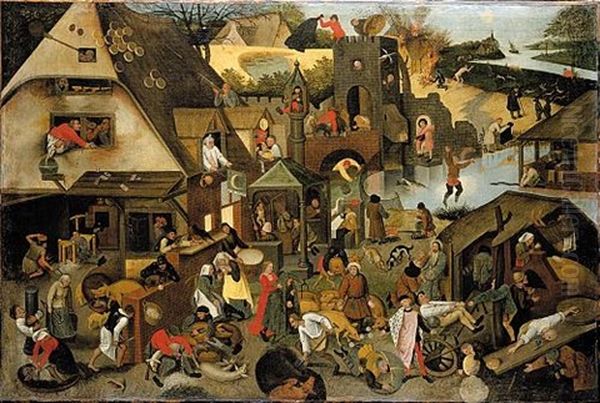
Modern scientific techniques have provided valuable tools for art historians. Dendrochronology (tree-ring dating of wood panels) can establish the earliest possible date for a painting. Infrared reflectography can reveal underdrawings beneath the paint layers, sometimes uncovering workshop patterns or sketches transferred from cartoons. Pigment analysis using methods like X-ray fluorescence (XRF) can identify materials used, helping to date paintings based on when certain pigments were available or commonly used. Fingerprint analysis has even been employed in attempts to link specific works to individual artists within the Brueghel circle. Despite these advances, connoisseurship – the expert judgment of style, technique, and quality – remains crucial, and debates over attribution continue for many works associated with Pieter Brueghel the Younger and his prolific studio.
Legacy and Influence
Pieter Brueghel the Younger's legacy is multifaceted. While often viewed primarily as a conduit for his father's genius, his role was far more active and significant than that of a mere copyist. By managing a highly efficient workshop, he ensured the survival and widespread popularity of Pieter Bruegel the Elder's compositions at a time when they might otherwise have faded into obscurity or remained known only to a select few. He effectively translated his father's mid-16th-century vision for a 17th-century audience, adapting and interpreting the works in subtle ways.
His own original paintings, though perhaps lacking the profound depth and innovative power of his father's best work, possess considerable charm, energy, and technical skill. They provide valuable insights into the social life, customs, and landscapes of the Southern Netherlands during his time. His depictions of village life, in particular, contributed significantly to the development and enduring popularity of genre painting in Flanders, influencing subsequent generations of artists, most notably David Teniers the Younger.
Commercially, he was undeniably successful, demonstrating astute management of his workshop and a keen understanding of the art market. The Brueghel 'brand' remained potent throughout his lifetime and beyond, thanks in large part to his efforts. He stands as a testament to the complex interplay of inheritance, innovation, and market forces within the history of art.
Conclusion
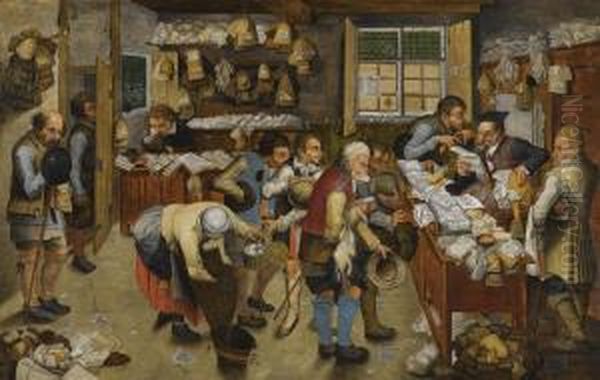
Pieter Brueghel the Younger occupies a unique and often underestimated place in art history. Born into the shadow of a legendary father, he embraced his heritage, becoming the primary disseminator of the Bruegelian vision through countless copies produced by his thriving Antwerp workshop. Yet, he was more than a replicator; he was an artist in his own right, creating vibrant original works and adapting his father's themes with his own distinct style. His career highlights the importance of workshop practices, the complexities of artistic legacy, and the enduring appeal of Flemish genre painting. Through his prolific output, Pieter Brueghel the Younger not only preserved his father's artistic world but also significantly contributed to the visual culture of his own time, leaving behind a body of work that continues to engage and delight viewers today.